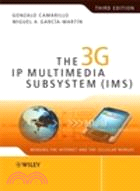The 3G Ip Multimedia Subsystem (Ims) - Merging The Internet And The Cellular Worlds 3E
商品資訊
ISBN13:9780470516621
出版社:John Wiley & Sons Inc
作者:Camarillo
出版日:2008/09/12
裝訂/頁數:精裝/664頁
規格:25cm*17cm (高/寬)
定價
:NT$ 5166 元優惠價
:90 折 4649 元
若需訂購本書,請電洽客服 02-25006600[分機130、131]。
商品簡介
目次
相關商品
商品簡介
Third edition of this best-selling guide to IMS: fully revised, and updated with brand new material
The IMS (IP Multimedia Subsystem) is the technology that merges the Internet with the cellular world. It makes Internet technologies such as the web, email, instant messaging, presence, and videoconferencing available nearly everywhere at any time.
The third edition of this bestselling book is fully updated and provides comprehensively expanded content, including new chapters on emergency calls and on Voice Call Continuity (VCC). As well as this, The 3G IP Multimedia Subsystem (IMS) presents updated material including a comprehensive picture of Session Initiation Protocol (SIP) as well as its applicability to IMS. As most of the protocols have been designed in the IETF, this book explains how the IETF developed these protocols and describes how these protocols are used in the IMS architecture.
This is an indispensable guide for engineers, programmers, business managers, marketing representatives and technically aware users who want to understand how the IMS works and explore the business model behind it.
New chapters on emergency calls, Voice Call Continuity (VCC), service configuration (XCAP, XDM), and conferencing
Fully updated throughout, including Policy and Charging Control (PCC), QoS, Presence, Instant Messaging, Multimedia Telephony Services, and Push-to-talk over Cellular (PoC)
Describes the IP Multimedia Subsystem from two different perspectives: from the IETF perspective, and from the 3GPP perspective.
Provides details on the latest policy technology and security architecture
Written by experienced professionals in the field.
The IMS (IP Multimedia Subsystem) is the technology that merges the Internet with the cellular world. It makes Internet technologies such as the web, email, instant messaging, presence, and videoconferencing available nearly everywhere at any time.
The third edition of this bestselling book is fully updated and provides comprehensively expanded content, including new chapters on emergency calls and on Voice Call Continuity (VCC). As well as this, The 3G IP Multimedia Subsystem (IMS) presents updated material including a comprehensive picture of Session Initiation Protocol (SIP) as well as its applicability to IMS. As most of the protocols have been designed in the IETF, this book explains how the IETF developed these protocols and describes how these protocols are used in the IMS architecture.
This is an indispensable guide for engineers, programmers, business managers, marketing representatives and technically aware users who want to understand how the IMS works and explore the business model behind it.
New chapters on emergency calls, Voice Call Continuity (VCC), service configuration (XCAP, XDM), and conferencing
Fully updated throughout, including Policy and Charging Control (PCC), QoS, Presence, Instant Messaging, Multimedia Telephony Services, and Push-to-talk over Cellular (PoC)
Describes the IP Multimedia Subsystem from two different perspectives: from the IETF perspective, and from the 3GPP perspective.
Provides details on the latest policy technology and security architecture
Written by experienced professionals in the field.
目次
Foreword by Stephen Hayes.
Foreword by Allison Mankin and Jon Peterson.
Preface to the Third Edition.
Preface to the Second Edition.
Preface to the First Edition.
Acknowledgements.
Part I Introduction to the IMS.
IMS Vision: Where Do We Want to Go?
1.1 The Internet.
1.2 The Cellular World.
1.3 Why do we need the IMS?
1.4 Relation between IMS and non-IMS Services.
2 The History of the IMS Standardization.
2.1 Relations between IMS-related Standardization Bodies.
2.3 Third Generation Partnership Project.
2.4 Third Generation Partnership Project 2.
2.5 IETF-3GPP/3GPP2 Collaboration.
2.6 Open Mobile Alliance.
3 General Principles of the IMS Architecture.
3.1 From Circuit-switched to Packet-switched.
3.2 IMS Requirements.
3.3 Overview of Protocols used in the IMS.
3.4 Overview of IMS Architecture.
3.5 Identification in the IMS.
3.6 SIM, USIM, and ISIM in 3GPP.
3.7 Next Generation Networks (NGN).
Part II The Signaling Plane in the IMS.
4 Session Control on the Internet.
4.1 SIP Functionality.
4.2 SIP Entities.
4.3 Message Format.
4.4 The Start Line in SIP Responses: the Status Line.
4.5 The Start Line in SIP Requests: the Request Line.
4.6 Header Fields.
4.7 Message Body.
4.8 SIP Transactions.
4.9 Message Flow for Session Establishment.
4.10 SIP Dialogs.
4.11 Extending SIP.
4.12 Caller Preferences and User Agent Capabilities.
4.13 Reliability of Provisional Responses.
4.14 Preconditions.
4.15 Event Notification.
4.16 Signaling Compression.
4.17 Content Indirection.
4.18 The REFER Method.
4.19 Globally Routable User- Agent URIs (GRUU).
4.20 NAT Traversal.
5 Session Control in the IMS.
5.1 Prerequisites for Operation in the IMS.
5.2 IPv4 and IPv6 in the IMS.
5.3 IP Connectivity Access Network.
5.4 P-CSCF Discovery.
5.5 IMS-level Registration.
5.6 Subscription to the reg Event State.
5.7 Basic Session Setup.
5.8 Application Servers: Providing Services to Users.
5.9 Changes due to Next Generation Networks (NGN).
5.10 Interworking.
5.11 Combinational Services.
5.12 Basic Sessions not Requiring Resource Reservation.
5.13 Globally Routable User-Agent URI (GRUU) in IMS.
5.14 IMS Communication Services Identification (ICSI).
5.15 IMS Application Reference Identifier (IARI).
5.16 NAT Traversal in the IMS.
6 AAA on the Internet.
6.1 Authentication, Authorization, and Accounting.
6.2 AAA Framework on the Internet.
6.3 The Diameter Protocol.
7 AAA in the IMS.
7.1 Authentication and Authorization in the IMS.
7.2 he Cx and Dx Interfaces.
7.3 The Sh Interface.
7.4 Accounting.
8 Policy and Charging Control in the IMS.
8.1 PCC Architecture.
8.2 Charging Architecture.
8.3 Offline Charging Architecture.
8.4 Online Charging Architecture.
9 Quality of Service on the Internet.
9.1 Integrated Services.
9.2 Differentiated Services.
10 Quality of Service in the IMS.
10.1 Policy Control and QoS.
10.2 Instructions to Perform Resource Reservations.
10.3 Reservations by the Terminals.
10.4 QoS in the Network.
11 Security on the Internet.
11.1 HTTP Digest Access Authentication.
11.2 Certificates.
11.3 TLS.
11.4 S/MIME.
11.5 Authenticated Identity Body.
11.6 IPsec.
11.7 Privacy.
11.8 Encrypting Media Streams.
12 Security in the IMS.
12.1 Access Security.
12.2 Network Security.
13 Emergency Calls on the Internet.
13.1 Introduction.
13.2 Location Acquisition.
13.3 Identifying Emergency Calls.
13.4 Locating the closest PSAP.
14 Emergency Calls in the IMS.
14.1 Architecture for Supporting Emergency Calls in IMS.
14.2 Establishing an Emergency Call in IMS.
14.3 IMS Registration for Emergency Calls.
14.4 Call back from PSAP to user.
14.5 Anonymous calls.
14.6 Emergency Calls in Fixed Broadband Accesses.
Part III The Media Plane in the IMS.
15 Media Encoding.
15.1 Speech Encoding.
15.2 Video Encoding.
15.3 Text Encoding.
15.4 Mandatory Codecs in the IMS.
16 Media Transport.
16.1 Reliable Media Transport.
16.2 Unreliable Media Transport.
16.3 Media Transport in the IMS.
Part IV Building Services with the IMS.
17 Service Configuration on the Internet.
17.1 The XML Configuration Access Protocol (XCAP).
17.2 An Overview of XML.
17.3 HTTP URIs that Identify XCAP Resources.
17.4 XCAP operations.
17.5 Entity Tags and Conditional Operations.
17.6 Subscriptions to Changes in XML Documents.
17.7 XML Patch Operations.
18 Service Configuration in the IMS.
18.1 XDM architecture.
18.2 Downloading an XML document, attribute, or element.
18.3 Directory Retrieval.
18.4 Data Search with XDM.
18.5 Subscribing to Changes in XML Documents.
19 The Presence Service on the Internet.
19.1 Overview of the Presence Service.
19.2 The Presence Life Cycle.
19.3 Presence Subscriptions and Notifications.
19.4 Presence Publication.
19.5 Presence Information Data Format (PIDF).
19.6 The Presence Data Model for SIP.
19.7 Mapping the SIP Presence Data Model to the PIDF.
19.8 Rich Presence Information Data Format.
19.9 CIPID.
19.10 Timed Presence Extension to the PIDF.
19.11 Presence Capabilities.
19.12 Geographical Location in Presence.
19.13 Watcher Information.
19.14 Watcher Authorization: Presence Authorization Rules.
19.15 URI-list Services and Resource Lists.
19.16 Presence Optimizations.
20 The Presence Service in the IMS.
20.1 The Foundation of Services.
20.2 Presence Architecture in the IMS.
20.3 Presence Publication.
20.4 Watcher Subscription.
20.5 Watcher Information and Authorization of Watchers.
20.6 Presence Optimizations.
20.7 OMA extensions to PIDF.
21 Instant Messaging on the Internet.
21.1 The im URI.
21.2 Modes of Instant Messages.
21.3 Pager-mode Instant Messaging.
21.4 Session-based Instant Messaging.
21.5 The “isComposing” Indication.
21.6 Messaging Multiple Parties.
21.7 File Transfer.
22 The Instant Messaging Service in the IMS.
22.1 Pager-mode Instant Messaging in the IMS.
22.2 Pager-mode Instant Messaging to Multiple Recipients.
22.3 Session-based Instant Messaging in the IMS.
22.4 File Transfer.
23 Conferencing on the Internet.
23.1 Conferencing Standardization at the IETF.
23.2 The SIPPING Conferencing Framework.
23.3 The XCON Conferencing Framework.
23.4 The Binary Floor Control Protocol (BFCP).
24 Conferencing in the IMS.
24.1 The IMS Conferencing Service.
24.2 Relation with the work in TISPAN and OMA.
25 Push-to-Talk over Cellular.
25.1 PoC Standardization.
25.2 IETF Work Relevant to PoC.
25.3 Architecture.
25.4 Registration.
25.5 PoC Server Roles.
25.6 PoC Session Types.
25.7 Adding Users to a PoC Session.
25.8 Group Advertisements.
25.9 Session Establishment Types.
25.10 Answer Modes.
25.11 Right-to-send-media Indication Types.
25.12 Participant Information.
25.13 Barring and Instant Personal Alerts.
25.14 Full Duplex Call Follow on.
25.15 The User Plane.
25.16 Simultaneous PoC Sessions.
25.17 Charging in PoC.
26 Multimedia Telephony Services: PSTN/ISDN Simulation Services.
26.1 Providing Audible Announcements.
26.2 Communication Diversion (CDIV).
26.3 Communication Diversion Notification (CDIVN).
26.4 Conference (CONF).
26.5 Message Waiting Indication (MWI).
26.6 OIP and OIR.
26.7 TIP and TIR.
26.8 ACRACR and CB.
26.9 Advice of Charge (AoC).
26.10 CCBS and CCNR.
26.11 Malicious Communication Identification (MCID).
26.12 Communication Hold (HOLD).
26.13 Explicit Communication Transfer (ECT).
26.14 User Settings in PSTN/ISDN Simulation Services.
27 Voice Call Continuity (VCC).
27.1 Overview of Voice Call Continuity.
27.2 VCC architecture.
27.3 Registration.
27.4 Call origination and anchoring.
27.5 Call termination and anchoring.
27.6 Domain Transfer.
Appendix A List of IMS-related Specifications.
A.1 Introduction.
A.2 3GPP Specifications.
A.3 ETSI NGN Specifications.
A.4 OMA Specifications.
References.
Index.
Foreword by Allison Mankin and Jon Peterson.
Preface to the Third Edition.
Preface to the Second Edition.
Preface to the First Edition.
Acknowledgements.
Part I Introduction to the IMS.
IMS Vision: Where Do We Want to Go?
1.1 The Internet.
1.2 The Cellular World.
1.3 Why do we need the IMS?
1.4 Relation between IMS and non-IMS Services.
2 The History of the IMS Standardization.
2.1 Relations between IMS-related Standardization Bodies.
2.3 Third Generation Partnership Project.
2.4 Third Generation Partnership Project 2.
2.5 IETF-3GPP/3GPP2 Collaboration.
2.6 Open Mobile Alliance.
3 General Principles of the IMS Architecture.
3.1 From Circuit-switched to Packet-switched.
3.2 IMS Requirements.
3.3 Overview of Protocols used in the IMS.
3.4 Overview of IMS Architecture.
3.5 Identification in the IMS.
3.6 SIM, USIM, and ISIM in 3GPP.
3.7 Next Generation Networks (NGN).
Part II The Signaling Plane in the IMS.
4 Session Control on the Internet.
4.1 SIP Functionality.
4.2 SIP Entities.
4.3 Message Format.
4.4 The Start Line in SIP Responses: the Status Line.
4.5 The Start Line in SIP Requests: the Request Line.
4.6 Header Fields.
4.7 Message Body.
4.8 SIP Transactions.
4.9 Message Flow for Session Establishment.
4.10 SIP Dialogs.
4.11 Extending SIP.
4.12 Caller Preferences and User Agent Capabilities.
4.13 Reliability of Provisional Responses.
4.14 Preconditions.
4.15 Event Notification.
4.16 Signaling Compression.
4.17 Content Indirection.
4.18 The REFER Method.
4.19 Globally Routable User- Agent URIs (GRUU).
4.20 NAT Traversal.
5 Session Control in the IMS.
5.1 Prerequisites for Operation in the IMS.
5.2 IPv4 and IPv6 in the IMS.
5.3 IP Connectivity Access Network.
5.4 P-CSCF Discovery.
5.5 IMS-level Registration.
5.6 Subscription to the reg Event State.
5.7 Basic Session Setup.
5.8 Application Servers: Providing Services to Users.
5.9 Changes due to Next Generation Networks (NGN).
5.10 Interworking.
5.11 Combinational Services.
5.12 Basic Sessions not Requiring Resource Reservation.
5.13 Globally Routable User-Agent URI (GRUU) in IMS.
5.14 IMS Communication Services Identification (ICSI).
5.15 IMS Application Reference Identifier (IARI).
5.16 NAT Traversal in the IMS.
6 AAA on the Internet.
6.1 Authentication, Authorization, and Accounting.
6.2 AAA Framework on the Internet.
6.3 The Diameter Protocol.
7 AAA in the IMS.
7.1 Authentication and Authorization in the IMS.
7.2 he Cx and Dx Interfaces.
7.3 The Sh Interface.
7.4 Accounting.
8 Policy and Charging Control in the IMS.
8.1 PCC Architecture.
8.2 Charging Architecture.
8.3 Offline Charging Architecture.
8.4 Online Charging Architecture.
9 Quality of Service on the Internet.
9.1 Integrated Services.
9.2 Differentiated Services.
10 Quality of Service in the IMS.
10.1 Policy Control and QoS.
10.2 Instructions to Perform Resource Reservations.
10.3 Reservations by the Terminals.
10.4 QoS in the Network.
11 Security on the Internet.
11.1 HTTP Digest Access Authentication.
11.2 Certificates.
11.3 TLS.
11.4 S/MIME.
11.5 Authenticated Identity Body.
11.6 IPsec.
11.7 Privacy.
11.8 Encrypting Media Streams.
12 Security in the IMS.
12.1 Access Security.
12.2 Network Security.
13 Emergency Calls on the Internet.
13.1 Introduction.
13.2 Location Acquisition.
13.3 Identifying Emergency Calls.
13.4 Locating the closest PSAP.
14 Emergency Calls in the IMS.
14.1 Architecture for Supporting Emergency Calls in IMS.
14.2 Establishing an Emergency Call in IMS.
14.3 IMS Registration for Emergency Calls.
14.4 Call back from PSAP to user.
14.5 Anonymous calls.
14.6 Emergency Calls in Fixed Broadband Accesses.
Part III The Media Plane in the IMS.
15 Media Encoding.
15.1 Speech Encoding.
15.2 Video Encoding.
15.3 Text Encoding.
15.4 Mandatory Codecs in the IMS.
16 Media Transport.
16.1 Reliable Media Transport.
16.2 Unreliable Media Transport.
16.3 Media Transport in the IMS.
Part IV Building Services with the IMS.
17 Service Configuration on the Internet.
17.1 The XML Configuration Access Protocol (XCAP).
17.2 An Overview of XML.
17.3 HTTP URIs that Identify XCAP Resources.
17.4 XCAP operations.
17.5 Entity Tags and Conditional Operations.
17.6 Subscriptions to Changes in XML Documents.
17.7 XML Patch Operations.
18 Service Configuration in the IMS.
18.1 XDM architecture.
18.2 Downloading an XML document, attribute, or element.
18.3 Directory Retrieval.
18.4 Data Search with XDM.
18.5 Subscribing to Changes in XML Documents.
19 The Presence Service on the Internet.
19.1 Overview of the Presence Service.
19.2 The Presence Life Cycle.
19.3 Presence Subscriptions and Notifications.
19.4 Presence Publication.
19.5 Presence Information Data Format (PIDF).
19.6 The Presence Data Model for SIP.
19.7 Mapping the SIP Presence Data Model to the PIDF.
19.8 Rich Presence Information Data Format.
19.9 CIPID.
19.10 Timed Presence Extension to the PIDF.
19.11 Presence Capabilities.
19.12 Geographical Location in Presence.
19.13 Watcher Information.
19.14 Watcher Authorization: Presence Authorization Rules.
19.15 URI-list Services and Resource Lists.
19.16 Presence Optimizations.
20 The Presence Service in the IMS.
20.1 The Foundation of Services.
20.2 Presence Architecture in the IMS.
20.3 Presence Publication.
20.4 Watcher Subscription.
20.5 Watcher Information and Authorization of Watchers.
20.6 Presence Optimizations.
20.7 OMA extensions to PIDF.
21 Instant Messaging on the Internet.
21.1 The im URI.
21.2 Modes of Instant Messages.
21.3 Pager-mode Instant Messaging.
21.4 Session-based Instant Messaging.
21.5 The “isComposing” Indication.
21.6 Messaging Multiple Parties.
21.7 File Transfer.
22 The Instant Messaging Service in the IMS.
22.1 Pager-mode Instant Messaging in the IMS.
22.2 Pager-mode Instant Messaging to Multiple Recipients.
22.3 Session-based Instant Messaging in the IMS.
22.4 File Transfer.
23 Conferencing on the Internet.
23.1 Conferencing Standardization at the IETF.
23.2 The SIPPING Conferencing Framework.
23.3 The XCON Conferencing Framework.
23.4 The Binary Floor Control Protocol (BFCP).
24 Conferencing in the IMS.
24.1 The IMS Conferencing Service.
24.2 Relation with the work in TISPAN and OMA.
25 Push-to-Talk over Cellular.
25.1 PoC Standardization.
25.2 IETF Work Relevant to PoC.
25.3 Architecture.
25.4 Registration.
25.5 PoC Server Roles.
25.6 PoC Session Types.
25.7 Adding Users to a PoC Session.
25.8 Group Advertisements.
25.9 Session Establishment Types.
25.10 Answer Modes.
25.11 Right-to-send-media Indication Types.
25.12 Participant Information.
25.13 Barring and Instant Personal Alerts.
25.14 Full Duplex Call Follow on.
25.15 The User Plane.
25.16 Simultaneous PoC Sessions.
25.17 Charging in PoC.
26 Multimedia Telephony Services: PSTN/ISDN Simulation Services.
26.1 Providing Audible Announcements.
26.2 Communication Diversion (CDIV).
26.3 Communication Diversion Notification (CDIVN).
26.4 Conference (CONF).
26.5 Message Waiting Indication (MWI).
26.6 OIP and OIR.
26.7 TIP and TIR.
26.8 ACRACR and CB.
26.9 Advice of Charge (AoC).
26.10 CCBS and CCNR.
26.11 Malicious Communication Identification (MCID).
26.12 Communication Hold (HOLD).
26.13 Explicit Communication Transfer (ECT).
26.14 User Settings in PSTN/ISDN Simulation Services.
27 Voice Call Continuity (VCC).
27.1 Overview of Voice Call Continuity.
27.2 VCC architecture.
27.3 Registration.
27.4 Call origination and anchoring.
27.5 Call termination and anchoring.
27.6 Domain Transfer.
Appendix A List of IMS-related Specifications.
A.1 Introduction.
A.2 3GPP Specifications.
A.3 ETSI NGN Specifications.
A.4 OMA Specifications.
References.
Index.
主題書展
更多
主題書展
更多書展今日66折
您曾經瀏覽過的商品
購物須知
外文書商品之書封,為出版社提供之樣本。實際出貨商品,以出版社所提供之現有版本為主。部份書籍,因出版社供應狀況特殊,匯率將依實際狀況做調整。
無庫存之商品,在您完成訂單程序之後,將以空運的方式為你下單調貨。為了縮短等待的時間,建議您將外文書與其他商品分開下單,以獲得最快的取貨速度,平均調貨時間為1~2個月。
為了保護您的權益,「三民網路書店」提供會員七日商品鑑賞期(收到商品為起始日)。
若要辦理退貨,請在商品鑑賞期內寄回,且商品必須是全新狀態與完整包裝(商品、附件、發票、隨貨贈品等)否則恕不接受退貨。
























